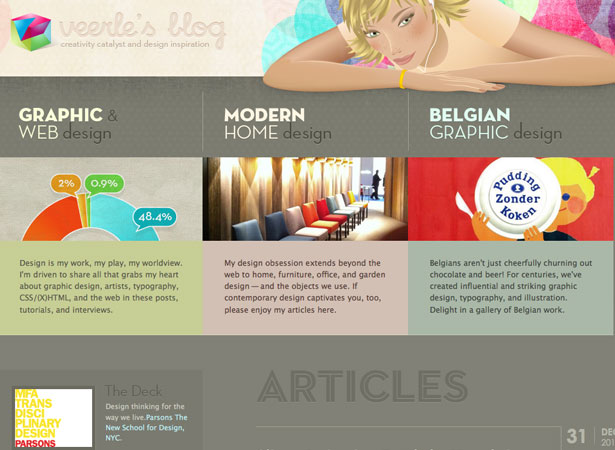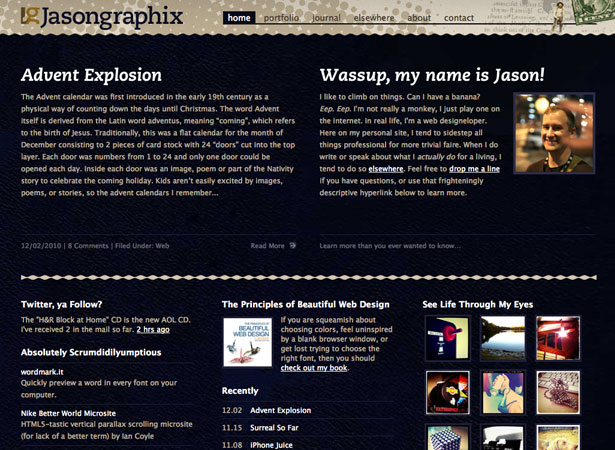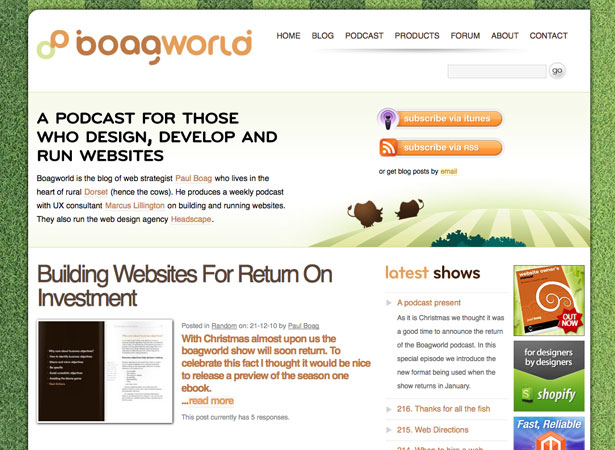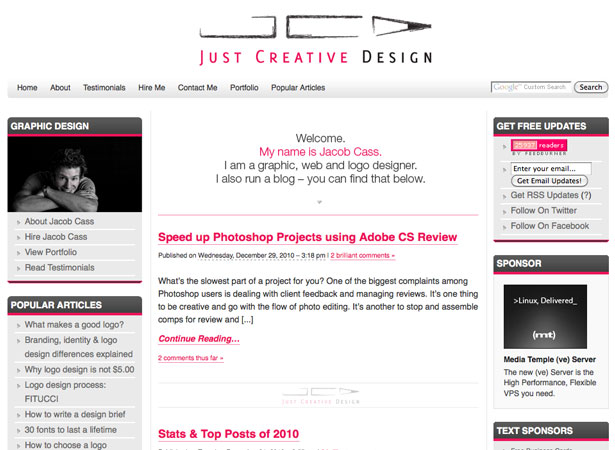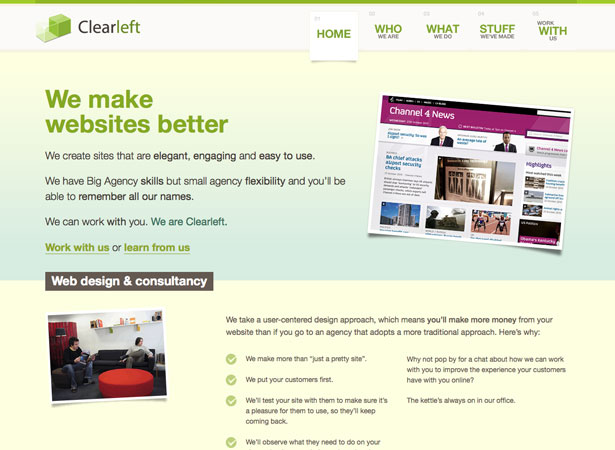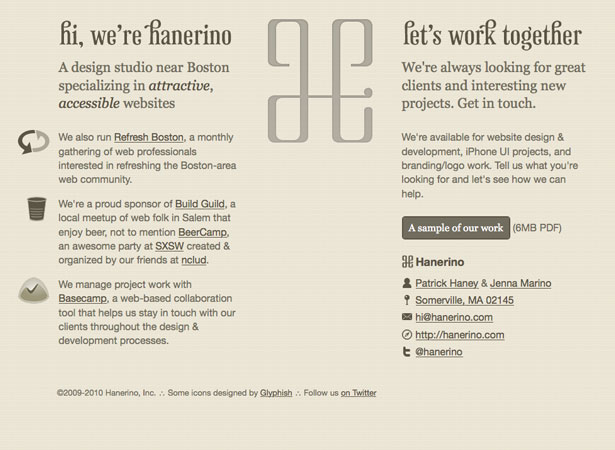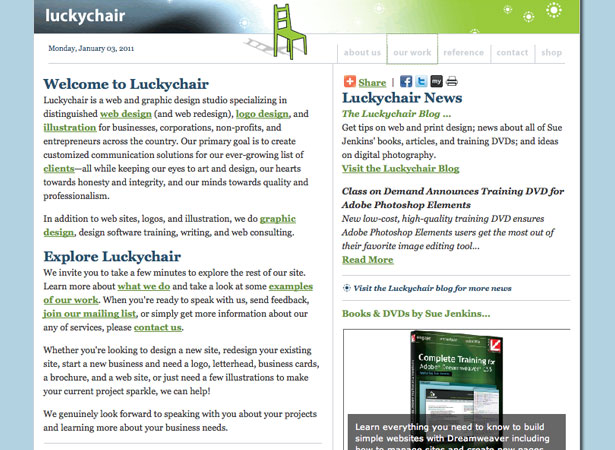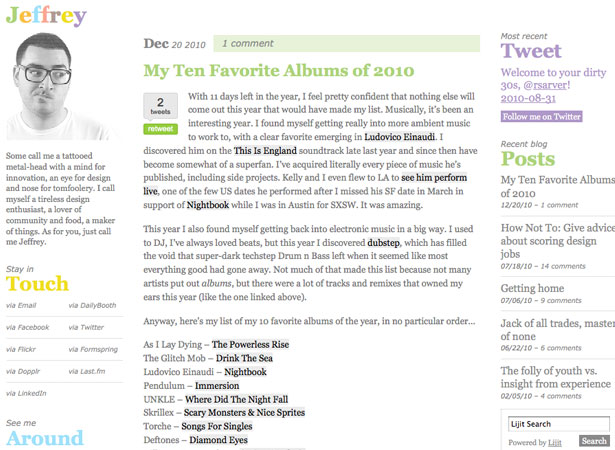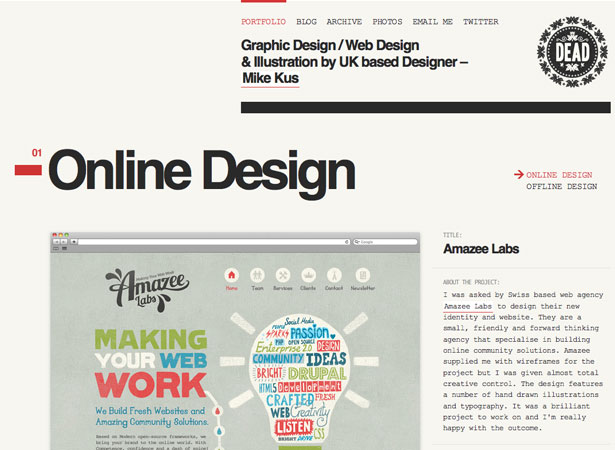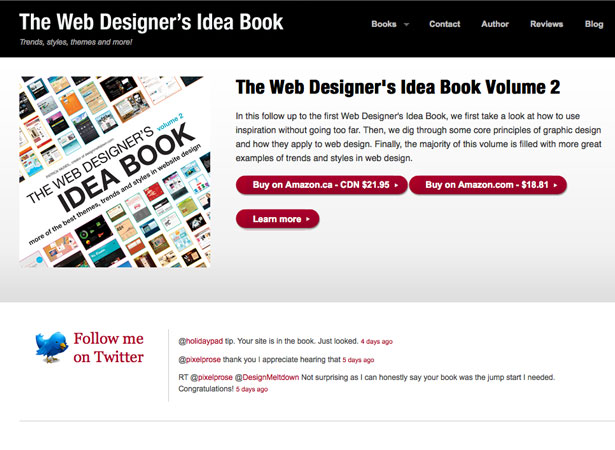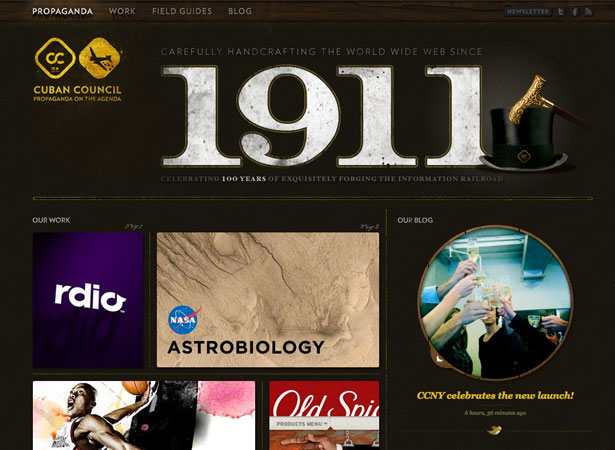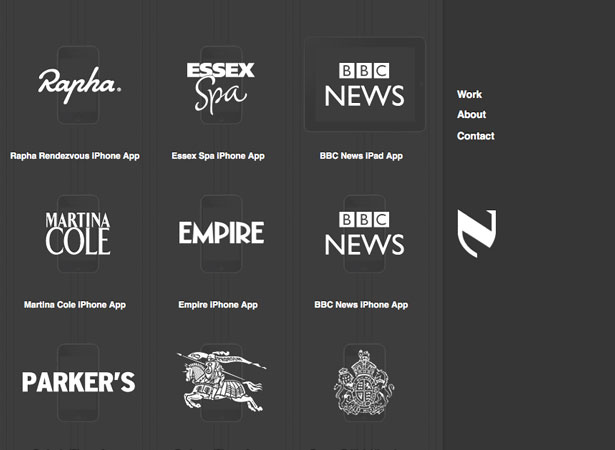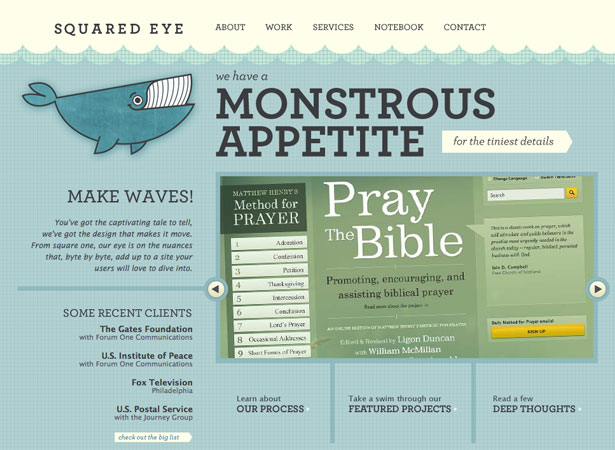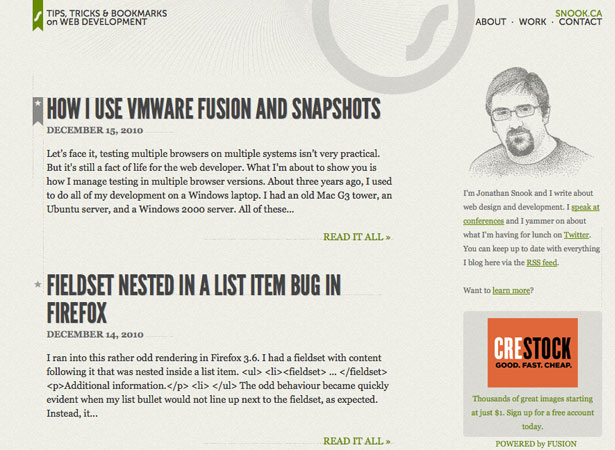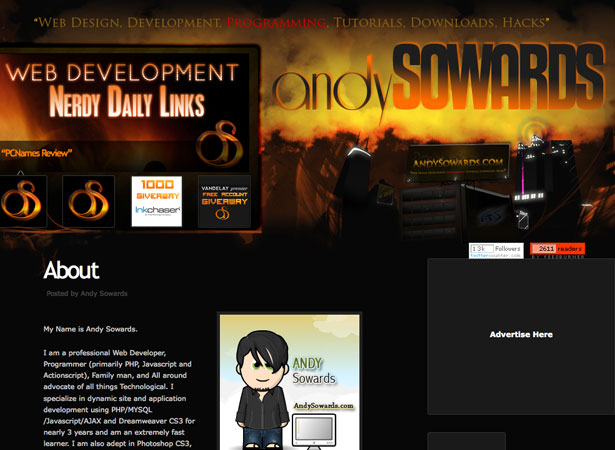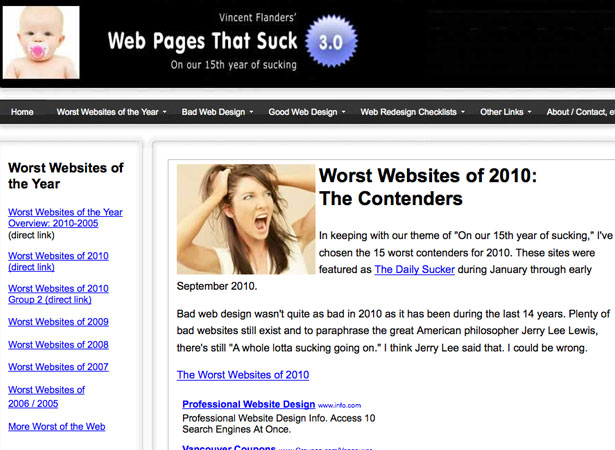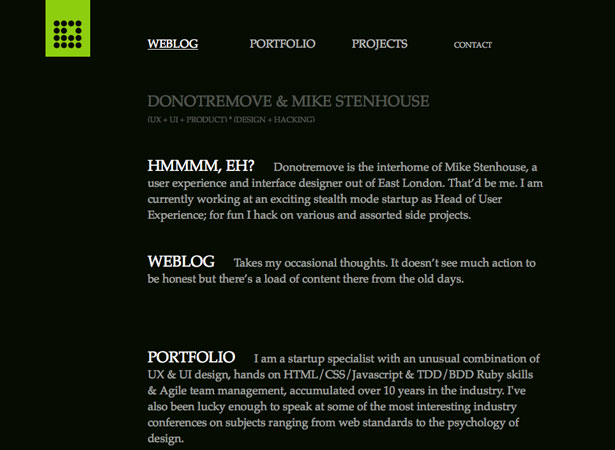 As is most often the case with the Internet, many of the trends and products people are talking about today weren't part of our collective lexicon two and three years ago. And some, weren't even discussed as recent as the first quarter of 2010!
As is most often the case with the Internet, many of the trends and products people are talking about today weren't part of our collective lexicon two and three years ago. And some, weren't even discussed as recent as the first quarter of 2010!
As we head into the New Year, we were curious about what we can all expect to see in Web Design in 2011, and asked some of the leading Web Designers and Web Design Writers in the field for their predictions.
After you’ve had a chance to read their illuminating thoughts, please take a moment and tell us your predictions, too.
Best wishes for a happy, healthy and well-designed 2011!
Veerle Pieters
If we can believe pantone, pink will have its mark on 2011 :) I'm guessing we will also see richer and stronger typography as it will further grow and mature thanks to services like Typekit, Fontdeck, etc.
Mobile will become even more important with the launch of iPad 2 and all other tablets that want to step in the iPads footsteps.
For the rest, if I am being honest, I'm not really into this whole *trends* of 2011. I'm a strong believer of "doing your own thing" and not looking at what others are doing or what will be popular. If somebody would say gradients are out I'm saying I still will use them if they fit what I'm designing.
Veerle Pieters, @vpieters, is a graphic/web designer living in Belgium. My personal journal reflects my journeys through design, the web, and life.
Jason Beaird
Anyone who's been working on the web for more than a few years would agree that 2010 was a milestone year for front-end development. The tools and tricks of our industry are always evolving, but the explosion of webfonts, CSS3 and HTML5 over the last year has made for an exciting ride. I predict that this new found momentum will continue in 2011 and that we'll see even more exciting and beautiful sites exploiting these technologies.
On the pure design front, I think all of our bold CSS3 experiments will give way to more minimalist trends this year. Subtle will become the new black and that will apply to our color choices, backgrounds, borders, shadows and gradients.
I don't think the same will be true of typography. I predict that 2011 will be a banner year for typographic exploration and that webfont-powered typefaces will play an even bigger role in online brand identity.
Having just finished reading Khoi Vinh's excellent "Ordering Disorder: Grid Principles for Web Design", I also predict that we'll see even more focus on grid-based design in 2011. Our use of grids will extend far beyond the "trusty 960"- that has become the defacto standard to more accurately address our client's specific goals.
The surge in tablet computing will revive the old fluid vs. fixed debate and will result in more "responsive"designs. Finally,I think we'll see a dramatic decrease in stock photo use in the coming year. The rise of mobile camera apps like Instagram and Hipstamatic have made a lot of web designers feel like amateur photographers. I believe this will result in more designers taking the pictures they need for client projects rather than paying the ever-increasing prices of microstock.
Jason Beaird, @jasongraphix, is the author of the recently revised "Principles of Beautiful Web Design" and currently works as a contract UX designer for MailChimp. He loves designing for the web and enjoys sharing this passion with other local web designers through Refresh Columbia.
Paul Boag
Making predictions like this is always a risky business as anything you say is guesswork at best. However I believe that I'm fairly safe in saying that 2011 will be the year of alternative devices. By that I mean more and more people will be accessing the web via a device other than their desktop PC or laptop. And I'm not just talking about the iPhone or iPads. We can expect to see an explosion of Android and Window devices.
This has all kinds of ramifications for us as web designers. Sites will need to be more flexible than ever and I expect to see many more people adopting responsive design techniques. However I believe that this is just the tip of the iceberg. Responsive design is great but does not take into account the varying contexts people will now be accessing the web in. For example the requirements of a user sitting in front of their desktop PC at home is very different from somebody accessing your site via smart phone on a busy train.
Paul Boag, @boagworld, Founder of web design agency Headscape, host of the boagworld web design podcast and author of the website owners manual.
Jacob Cass
Trends in web design come and go at a very a quick pace so you really need to be at the top of your game to understand what the limitations and opportunities are when it comes to designing for the web. Know what's been done, what's being done and what's just around the corner.
If you follow the industry, you should know about some of the up and coming trends already; web fonts, social sharing, personalized content and much more emphasis on faster loading speeds and optimization for mobile devices.
Jacob Cass, @justcreative, is an Aussie designer based in NYC who runs the websites Just Creative Design & Logo Of The Day.
Clearleft
I think 2011 will be the year of the reader. Better screens (both desktop and mobile) and the continued rise of optimized reading services like Instapaper will hopefully herald the end of that "people don't read online" myth. If so, we can also expect an overdue backlash against reader-hostile practices like splitting content across multiple pages and intrusive advertising. — Cennydd Bowles, Clearleft
I think we're going to see web fonts go mainstream in 2011, with more and more sites ditching techniques like Cufon in favour of native technologies. We're going to see IE 6 finally disappear, if we haven't already. However the biggest thing next year is going to be the move into mobile. Companies are finally going to realize that having a mobile strategy doesn't just mean commissioning an iPad app. Instead we're going to see more and more companies create mobile optimized versions of their websites using media queries. As such I think 2011 is going to be the year of responsive design. — Richard Rutter, Font Deck
With more and more digital applications like the iPlayer being designed for TV viewing I think 2011 is going to be a big year for transmedia. In the UK, all the major TV channels are behind the launch of a new digital box called YouView. Built around common web standards, it's a platform for developing and deploying interactive experiences on the TV. In the US, innovative start-ups like Kevin Slavin's Starling application aims to make TV a more social experience. As such I predict that 2011 will be the year when digital applications start to make inroads into the front room. — Andy Budd, Clearleft
Clearleft, @clearleft , is a team of eleven specialists: designers, developers, authors, thinkers and web afficionados. Clearleft formed in 2005, bringing together three fine gentlemen with a reputation for user-centred design, accessibility and web standards. We quickly found ourselves a home in Brighton’s cosmopolitan North Laine, and set about trying to make the online world a better place.
Patrick Haney
While design for mobile devices (including the iPad) is quickly gaining traction, and responsive web design is the talk of the web-connected town, my predictions for web design in 2011 center around HTML5 and web typography.
First, I predict a return to what some call the "Interactive Web." With Flash, we had real interaction on websites across the Internet, but at a cost of poorly designed splash screens and background music from DJ Where's The Mute Button. After years of returning to static pages and images, we're moving back to interactivity without Flash thanks to easy-to-use JavaScript libraries like jQuery. Moving forward, I see HTML5 & CSS3 taking us to the next phase of the Interactive Web thanks to advanced CSS features like animation, opacity and transitions.
Second, typography on the web is drastically changing for the better, which we'll see more of in 2011. Clients will ask for typefaces other than Georgia, Arial and Helvetica, and without having to generate images for headlines, we as designers will be able to grant such a request. While services like TypeKit and Fontdeck are wonderful (see Lost Worlds Fairs for what's possible with Typekit alone), the real font revolution will only happen as @font-face gains more browser support and font foundries are persuaded to change their licensing to follow suit. That may not happen in a year's time, but we're on the right track, and that's a good thing for designers and everyone else that uses the web.
Patrick Haney, @notasausage, is not a sausage. He's the co-creator of Hanerino, a design studio based just north of Boston. When he's not traveling the world and speaking at conferences, he enjoys teaching classes on web design & development as an adjunct instructor at the Center for Digital Imaging Arts
Sue Jenkins
Sure 2010 brought us HTML5, CSS3, and more apps than you can shake a stick at, but 2011 looks very promising for web designers. Here are my predictions (and wishes):
- In 2011, we’ll see the official retirement of IE6 (yippie!) and the projected retirement of IE7.
- The development of a new app that automatically generates a mobile version of CSS for your site based on your site’s main CSS file.
- The ability to use any font on the web based on the fonts loaded on a specified computer. The end of people talking about “Web 2.0”
- IE9 that renders code as beautifully as Firefox, Safari, Chrome, and Opera
- New WordPress WYSIWYG plug-ins that help designers customize WP templates visually
- New controls in Dreamweaver CS6 to generate robust pure CSS dropdown menus as well as new dialogs in Dreamweaver CS6 that allow designers to more easily customize Spry elements
- The reinstatement of IE7 and IE8 on Spoon.net
- And, in the spirit of world peace, 2011 will bring the development of a universal spam filter that prevents those jerks from littering our email inboxes with useless, annoying junk. No more Replica Watches and Viagra mail!
Sue Jenkins, @LuckychairNews, is a professional web/graphic designer, fine art photographer, Adobe Certified Instructor, and creative director at Luckychair. In addition, she is an award-winning software instructor in six Adobe Software Training DVDs and the author of several "For Dummies" instructional books on design including her most recents popular books Smashing Photoship CS5: 100 Professional Techniques, Web Design All-in-One For Dummies, and Dreamweaver CS5 All-in-One For Dummies.
Jeffrey Kalmikoff
User experience is on its way to becoming much more personal, and I'm excited to see how designers approach these challenges. I predict that we'll be seeing a lot more design for function, such as location features or social graph integration that are becoming more readily available, rather than simple trends of form.
The ability to leverage "known" information about a user such as social activity or interests from companies like Facebook, or location information via HTML5 or by using products from companies such as SimpleGeo, we'll find UI/UX design becoming more reactive to available information on a much more granular level. This could be as simple as updating UI based upon local time, weather, or relevant nearby social activity. Or, it could be as complex as planning for scalable content based upon what is relevant to a user's interests.
These new technologies have set us well on our way to much more personally relevant experiences online, and I look forward to the solutions the UI/UX community come up with to translate these technologies into elegant, highly-usable design.
Jeffrey Kalmikoff, @jeffrey. Some call him a tattooed metal-head with a mind for innovation, an eye for design and nose for tomfoolery. Others call him VP of Product for SimpleGeo, where they build kick-ass tools for developers to easily integrate location features into their apps. He calls himself a tireless design enthusiast, a lover of community and food, a maker of things. As for you, just call him Jeffrey.
Mike Kus
Designing for mobile devices like iPhones, iPads etc is going to be bigger than ever. I think web designers are now realising that this is where a large part of their profession is heading. It'll be exciting to see whether techniques like 'responsive web design' catch on or designers stick to the dedicated mobile site solution.
I also think as that as screen resolutions increase, designers will be faced with yet more challenges. Like with the iPhone 4 we might well have to increase image sizes for other devices which will obviously have an impact on the amount of data people download.
From an aesthetic point of view I still think a lot of web design is far too trend driven. I'd really love to see designers thinking more about the content of the site and the organisation they're designing for, and create work that's more meaningful for the users. Eg. The only point for putting a strip of fabric and some stitching across the top of your site is if you're designing it for a fabric/sewing store.
Mike Kus, @mikekus, is a Graphic/Web Designer & Illustrator based in Bath, UK. and Designer at Carsonified.com
Patrick McNeil
My prediction for 2011 as it relates to design is all focused on platforms. Every year we see web development focusing more on platforms to get things done. Each year it seems that fewer sites are built from scratch. It all makes perfect sense of course. Not only are there catch all platforms that can be massively customized to fit very specific needs, but there are also niche ones that solve specific (and common) industry needs. So why should a designer care?
This has a tremendous impact on the designer. In the print world, the best designers understand the medium the best. They know how to control the cost of the product by the design choices they make. The web is very much the same; the very best designers understand the medium, its limitations, opportunities and ways to control the price of the end product. I believe that in 2011 the difference between designers who simply design and let the developers sort through the implementation and those that understand the full process and can design thoughtful CMS friendly designs will become even more evident.
While I don’t expect designers to learn to develop, I do expect that they will continue to deepen their understanding of how the web, and more specifically, various CMS’s work. This means designing sites that can be effectively integrated into platforms and be maintained by business owners. The designer I see forming will not only be more effective, but will also be more profitable. This combination of talents is somewhat rare and hard to acquire.
Patrick McNeil, @DesignMeltdown, is a web developer, designer and the author of two books on web design titled The Web Designer's Idea Book. In his work he focuses on complex CMS integrations with a heavy usage of CSS and jQuery to get things done. His love of design and technology makes the web his ideal playground.
Toke Nygaard
I think there will be a lot of focus on how things feel, not so much how they look or work. Just like UI/UX became hot shit all of a sudden, I think a whole new wave of specialists in smoke and mirrors will emerge, who’s sole specialty is to make interaction feel great. I am talking about how things fade, animate, transition, sound. It is just going to hit a whole other level after iPad/iPhone showed us there is much more to learn in that field. Finally all the outcast Flash designers out there will have something to do again..
Toke Nygaard, @tokenygaard, is one of the trio who built K10k in the late 90’s and since then co-founded the web agency Cuban Council, a bi-coastal venture - currently heading up their New York office.
Ryan Shelton
With the rise of the iPhone, iPad and other touch devices from Android and Blackberry, 2011 will see web designers incorporating more touch focused design into websites.
Designing clever layouts that display and flow content well on both computer monitors as well as the smaller screens of mobile devices will become more common place and part of the workflow.
Just as web designers have been testing designs across different browsers so we will begin to see designers doing both cross browser testing as well as cross device testing. I also imagine design trends being influenced by the user interfaces of mobile devices such as Apple's iOS.
Ryan Shelton, @ryanshelton, is a UI and UX designer at The Noble Union, a design company based in London specialising in design and user experience. "We aim to create simple, intuitive, beautiful interfaces for the web and mobile devices."
Matthew Smith
I see the web getting more focused on ideas and moving away from technologies as the primary focus. We're watching browsers finally come together in some semblance of similarity now, and its allowing us to consolidate our thinking a bit in areas of technology, platforms, and browser types.
Now we're able to engage in questions about concept, ideas, delivery, experience. I would like to see web designers asking themselves and their clients about metaphors and stories that can be told through the experience of communicating content in a digital medium that moves, changes, breathes, pulses with life. It's not "print on screen" anymore. The web is clearly its own unique medium. We're potentially moving from the web's infancy into a stage of early development where real thinking starts to take shape.
Then again, I'm listening to the Inception soundtrack as I write this and that could be influencing my epic positive thinking.
It's possible that things are not so hopeful. I continue to see web designers place the wrong emphasis on style over meaning, and concern themselves with sexy pixels before successful projects with real return on investment for their clients. I know few web designers who are willing to accept that knowing how to push pixels with Photoshop or fireworks, or craft clean code with the three layered HTML/CSS/JS does not make you a web designer.
I am a web designer because I bend my mind toward the web medium, its unique differences and expanses of similarity to other design disciplines, and the simple but important facets of the Visual Language. I'm constantly learning more, and ever humbled at how little I know, but until we all grow in these areas and beyond simply mastering pixels and code, we'll be stuck in 2006.
Matthew Smith, @squaredeye, keeps a close eye on each square little pixel and grid that, arranged with intelligence and inspiration, form a design that helps us--and your company--grow.
Jonathan Snook
I anticipate that 2011 shall be the year where people will use CSS3 in droves. Many have still been reluctant, due to lack of support in Internet Explorer, but with the release of IE9, we'll finally have plenty of features at our fingertips.
Expect to see lots more experimentation and interesting tricks and hacks. I hope that we'll begin to see more people looking at the performance impacts of using CSS3 heavily in their projects.
Jonathan Snook, @snookca, is the creator of striking designs, impeccable markup and code, and forward-thinking ideas and applications.
Andy Sowards
I believe in the year 2011 we will be seeing a lot of very minimal sites with good user experience, that have subtle colors, lines, curves, textures and are pleasing to the eyes and simplifies everyones life. Every year we get busier and busier so its increasingly more popular to have a minimal layout that focuses on the content. Content will be king in 2011.
Also I believe we will begin to see the full potential of CSS3, HTML5 and Javascript begin to come to life. The web is going to become a more immersive experience and that is going to show in the designs, typography, and color usage that will we will be seeing. This in turn I believe will cause a more modern browser movement, and people will be more aware that they need to stay up to date to enjoy the web.
Andy Sowards, @andysowards, Passionate Creative that never stops. Avid Blogger, Freelancer, Web Designer, Developer, Programmer. Happy Hubby and Father of 4. My family is my motivation. Owner of Design and Programming blog.
Vincent Flanders
Mobile web sites/apps (It's the year of mobile.), tablet web sites/apps, exciting, new HTML5 tools will be released that will be misused by too many second level designers.
Designers will stop using #666 for text color on their clients' sites so text will be easier to read. Except for "Over-The-Top" websites, there will be 15% fewer sucky websites. (Bad news for me .)
Web page speed enhancement tools will be easier to use and page loading speed will get faster. (Google will be happier).
Designers will start using tools (or at least use .htaccess) to compress and cache files, which will make pages load faster and save petabytes of bandwidth.
Vincent Flanders, @vincentflanders, is a Usability analyst, author of two books on web design and creator of WebPagesThatSuck.com.
Mike Stenhouse
If 2010 was the year that mobile came of age then 2011 will see it move into its own apartment next door to the desktop and start throwing wild parties. Having started as the younger, slightly neglected sibling it's now on the verge of shouldering the desktop out of the way.
The industry (as articulated by Fred Wilson of Union Square Ventures) is coming around to the idea that mobile could often be the primary platform for new apps. As web developers and designers we are in a great position to take advantage of this shift through infrastructure enhancements like HTML5 and Phone Gap, and frameworks like jQuery Mobile, Zepto and Backbone, along with a horde of others.
All of these are based on technologies we already know and can start working with today. Rather than clumsily reskinning our websites, 2011 will be the year we embrace the philosophy of mobile to produce context aware, task tailored, fundamentally handheld apps.
Mike Stenhouse, @mikesten, is a user experience designer, occasional speaker and constant maker of things. When not tinkering he is Head of User Experience for video collaboration platform, Aframe.
Written exclusively for WDD by Debbie Hemley, @dhemley. Debbie is a blogger and social media aficionado. She works with businesses to develop content and social media strategies. Read her blog posts on All the News. You can also follow Debbie on LinkedIn.
Thumbnail image by: Shannonyeh Photography
What are your Web Design Predictions for 2011? Share your thoughts in the comments below.

